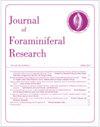印度洋马尔代夫有孔虫白化的现场观测
IF 0.9
4区 地球科学
Q4 PALEONTOLOGY
引用次数: 18
摘要
世界各地的珊瑚礁受到各种自然和人为因素的威胁;反常的气温是目前造成大面积珊瑚白化的最严重威胁之一。在光或温度引起的光氧化应激下,两栖藻表现出与珊瑚相似的白化,特别是在太阳辐照度最大的时候。在马尔代夫北阿里环礁的11个岛屿(34个采样点),在广泛的El Niñorelated珊瑚白化开始前几周观察到Amphistegina的白化现象,该地区的珊瑚白化程度比预期的要严重。利用凤头藻白化指数(ABI)评估,2015年4 - 5月凤头藻白化的比例可以解释为季节太阳辐照度和水透明度高峰期间温度超过30◦C的光抑制应激。重要的是,ABI表明,在大多数被调查的地点,环境条件适合两栖藻和其他钙化共生,并且在采样时存在慢性或相对较新的光氧化应激。在两栖藻中观察到的白化现象进一步证明了这些单细胞原生生物识别珊瑚礁中应激源的潜力;在未来的珊瑚礁管理计划中应考虑到这种申请。本文章由计算机程序翻译,如有差异,请以英文原文为准。
In Situ Observations of Foraminiferal Bleaching in the Maldives, Indian Ocean
Coral reefs are threatened worldwide by a variety of natural and human-induced stressors; anomalous temperatures are presently among the most serious threats by causing extensive coral bleaching. Amphistegina spp. exhibit similar bleaching as corals in the presence of photo-oxidative stress induced by either light or temperature, especially during times of maximum solar irradiance. At 11 islands (34 sampling sites) in the North Ari Atoll in the Maldives, bleaching in Amphistegina was observed a few weeks before the onset of an extensive El Niñorelated coral bleaching that was more severe than expected for this region. Assessment using the Amphistegina Bleaching Index (ABI) showed that the proportions of bleached specimens of Amphistegina in April–May 2015 can be explained by photoinhibitory stress associated with temperatures exceeding 30◦C during peak seasonal solar irradiance and water transparency. Importantly, the ABI indicates that environmental conditions are suitable for Amphistegina and other calcifying symbioses at most of the investigated sites, and that either chronic or relatively recent onset of photo-oxidative stress was present at the time of sampling. The observed bleaching in Amphistegina further demonstrates the potential of these unicellular protists to identify stressors in coral reefs; such applications should be considered in future reef-management plans.
求助全文
通过发布文献求助,成功后即可免费获取论文全文。
去求助
来源期刊
CiteScore
2.10
自引率
9.10%
发文量
32
审稿时长
>12 weeks
期刊介绍:
JFR publishes original papers of international interest dealing with the Foraminifera and allied groups of organisms. Review articles are encouraged.

 求助内容:
求助内容: 应助结果提醒方式:
应助结果提醒方式:


